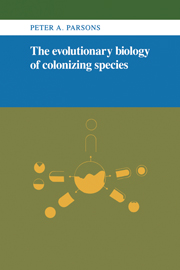Book contents
- Frontmatter
- Contents
- Preface
- 1 Introduction: Colonists and habitats
- 2 Genetics and ecology
- 3 Physical conditions, resources, and ecological phenotypes
- 4 Variability in natural populations
- 5 Genetic variability, ecological phenotypes, and stressful environments
- 6 Colonizing phenotypes and genotypes
- 7 Behavioral variability in natural populations
- 8 Habitat selection
- 9 The ecobehavioral phenotype: generalists and specialists
- 10 The ecobehavioral phenotype: biological control and domestication
- 11 Parasites and plants
- 12 Discussion and conclusions
- Appendix The study of quantitative traits
- References
- Index
5 - Genetic variability, ecological phenotypes, and stressful environments
Published online by Cambridge University Press: 15 September 2009
- Frontmatter
- Contents
- Preface
- 1 Introduction: Colonists and habitats
- 2 Genetics and ecology
- 3 Physical conditions, resources, and ecological phenotypes
- 4 Variability in natural populations
- 5 Genetic variability, ecological phenotypes, and stressful environments
- 6 Colonizing phenotypes and genotypes
- 7 Behavioral variability in natural populations
- 8 Habitat selection
- 9 The ecobehavioral phenotype: generalists and specialists
- 10 The ecobehavioral phenotype: biological control and domestication
- 11 Parasites and plants
- 12 Discussion and conclusions
- Appendix The study of quantitative traits
- References
- Index
Summary
The likelihood of organismic, instead of merely genie, selection goes far toward meeting one of the most serious objections to the theory of natural selection encountered by Darwin.
[Wright, 1980:841]Central and marginal populations
In the last 25 years, a substantial literature on genetic variation in central and marginal populations based upon gene (in particular, electrophoretic) and chromosome polymorphisms has been built up. Much of this information is based upon central and marginal habitats defined in a geographical sense, in contrast with the usually correlated ecological dichotomy of benign versus stressful.
Considering electrophoretic variants, levels of polymorphism generally do not vary much between central and marginal populations in several widespread Drosophila species. These include D. pseudoobscura (Prakash, Lewontin, and Hubby, 1969), D. robusta (Prakash, 1973a), D. willistoni (Ayala, Powell, and Dobzhansky, 1971), and D. subobscura (Marinković, Ayala, and Andjelković, 1978). Lewontin (1974) argued that genie heterozygosity is high in marginal populations, because the temporal instability of such environments means that no particular genotype is favored for long periods. This is supported by laboratory experiments in D. willistoni and D. pseudoobscura, indicating that heterozygosity is higher in heterogeneous than in constant environments (Powell, 1971; Powell and Wistrand, 1978). In addition, certain natural population surveys are suggestive of slightly higher gene variability levels in marginal populations, for example, in D. robusta (Prakash, 1973a) and D. melanogaster (Band, 1975); this agrees with the temporal (and, hence, ecological) instability interpretation. Extrapolation is, however, needed for other organisms, as suggested by Nevo and Yang's (1979) finding of greater genetic diversity in central populations of tree frogs in Israel. Here, climatic factors, primarily water availability, are shown to be the best predictors of polymorphism and heterozygosity levels.
- Type
- Chapter
- Information
- The Evolutionary Biology of Colonizing Species , pp. 63 - 86Publisher: Cambridge University PressPrint publication year: 1983



